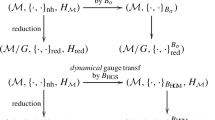Abstract
The two-body problem associated to an anisotropic Schwarzschild-type field is being tackled. Both the motion equations and the energy integral are regularized via McGehee-type transformations. The regular vector field exhibits nice symmetries that form a commutative group endowed with an idempotent structure. The physically fictitious flows on the collision and infinity manifolds, as well as the local flows in the neighbourhood of these manifolds, are fully described. Homothetic, spiral, and oscillatory orbits are pointed out. Some features of the global flow are depicted for all possible levels of energy. For the negative-energy case, few things have been done. The positive-energy global flow does not have zero-velocity curves; every orbit is of the type ejection – escape or capture – collision. In the zero-energy case, the collision and infinity manifolds have a very similar structure. The existence of eight trajectories that connect the equilibria on these manifolds is proved. The projectability of the zero-energy global flow completes the full understanding of the problem in this case.
Similar content being viewed by others
References
Brumberg, V. A.: 1991, Essential Relativistic Celestial Mechanics, Adam Hilger, Bristol, Philadelphia, New York.
Casasayas, J. and Llibre, J.: 1984, 'Qualitative analysis of the anisotropic Kepler problem', Mem. Amer. Math. Soc. Vol. 52, No. 312, American Mathematical Society, Providence, RI.
Chandrasekhar, S.: 1983, TheMathematical Theory of Black Holes, Oxford University Press, Oxford.
Craig, S., Diacu, F. N., Lacomba, E. A. and Perez, E.: 1999, 'On the anisotropic Manev problem', J. Math. Phys. 40, 1359-1375.
Delgado, J., Diacu, F. N., Lacomba, E. A., Mingarelli, A., Mioc, V., Perez, E. and Stoica, C.: 1996, 'The global flow of the Manev problem', J. Math. Phys. 37, 2748-2761.
Devaney, R. L.: 1978, 'Collision orbits in the anisotropic Kepler problem', Invent. Math. 45, 221-251.
Devaney, R. L.: 1981, 'Singularities in classical mechanical systems'. In: Ergodic Theory and Dynamical Systems, Vol. 1, Birkhäuser, Boston, pp. 211-333.
Diacu, F. N.: 1992, Singularities of the N-Body Problem. An Introduction to Celestial Mechanics, Les Publications CRM, Montréal.
Diacu, F. N., Mingarelli, A., Mioc, V. and Stoica, C.: 1995, 'The Manev two-body problem: quantitative and qualitative theory'. In: R. P. Agarwal (ed.), Dynamical Systems and Applications, World Scientific Series in Applicable Analysis, Vol. 4, World Scientific, Singapore, pp. 213-227.
Diacu, F. N., Mioc, V. and Stoica, C.: 2000, 'Phase-space structure and regularization of Manev-type problems', Nonlinear Anal. 41, 1029-1055.
Eddington, A. S.: 1923, Mathematical Theory of Relativity, Cambridge University Press, Cambridge.
Gutzwiller, M. C.: 1971, 'Periodic orbits and classical quantization conditions', J. Math. Phys. 12, 343-358.
Gutzwiller, M. C.: 1973, 'The anisotropic Kepler problem in two dimensions', J. Math. Phys. 14, 139-152.
Gutzwiller, M. C.: 1977, 'Bernoulli sequences and trajectories in the anisotropic Kepler problem', J. Math. Phys. 18, 806-823.
Gutzwiller, M. C.: 1990, Chaos in Classical Systems and Quantum Mechanics, Springer-Verlag, New York.
McGehee, R.: 1974, 'Triple collision in the collinear three-body problem', Invent. Math. 27, 191-227.
Maneff, G.: 1924, 'La gravitation et le principe de l'égalité de l'action et de la réaction', C. R. Acad. Sci. Paris 178, 2159-2161.
Maneff, G.: 1925, 'Die Gravitation und das Prinzip von Wirkung und Gegenwirkung', Z. Phys. 31, 786-802.
Maneff, G.: 1930a, 'Le principe de la moindre action et la gravitation', C. R. Acad. Sci. Paris 190, 963-965.
Maneff, G.: 1930b, 'La gravitation et l'énergie au zéro', C. R. Acad. Sci. Paris 190, 1374-1377.
Mioc, V. and Radu, E.: 1992, 'Orbits in an anisotropic radiation field', Astron. Nachr. 313, 353-357.
Mioc, V. and Stavinschi,M.: 1999, 'On Maxwell's (n+1)-body problem in the Manev-type field and on the associated restricted problem', Phys. Scripta 60, 483-490.
Mioc, V. and Stoica, C.: 1995a, 'Discussion et résolution complète du problème des deux corps dans le champ gravitationnel de Maneff', C. R. Acad. Sci. Paris, sér. I 320, 645-648.
Mioc, V. and Stoica, C.: 1995b, 'Discussion et résolution complète du problème des deux corps dans le champ gravitationnel de Maneff (II)', C. R. Acad. Sci. Paris, sér. I 321, 961-964.
Saslaw, W. C.: 1978, 'Motion around a source whose luminosity changes', Astrophys. J. 226, 240-252.
Savedoff, M. P. and Vila, S.: 1964, 'Dynamic effects of variable G or variable mass', Astron. J. 69, 242-245.
Schwarzschild, K.: 1916, 'Ñber das Gravitationsfeld eines Massenpunktes nach der Einsteinschen Theorie', Sitzber. Preuss. Akad. Wiss. Berlin, 189-196.
Stoica, C. and Mioc, V.: 1997, 'The Schwarzschild problem in astrophysics', Astrophys. Space Sci. 249, 161-173.
Vinti, J. P.: 1972, 'Possible effects of anisotropy of G on celestial orbits', Celest. Mech. 6, 198-207.
Will, C.: 1971, 'Relativistic gravity in the solar system. II. Anisotropy in the Newtonian gravitational constant', Astrophys. J. 169, 141-155.
Author information
Authors and Affiliations
Rights and permissions
About this article
Cite this article
Mioc, V., Pérez-Chavela, E. & Stavinschi, M. The Anisotropic Schwarzschild-Type Problem, Main Features. Celestial Mechanics and Dynamical Astronomy 86, 81–106 (2003). https://doi.org/10.1023/A:1023648616687
Issue Date:
DOI: https://doi.org/10.1023/A:1023648616687




